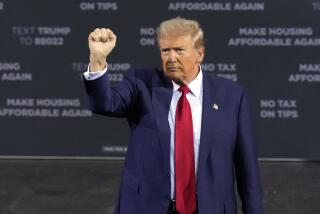Read His Lips? No, Watch His Hips : On the Art of Raising Taxes While Opposing Them
- Share via
Psssst. Don’t bother trying to read George Bush’s lips. Read his hips--his body language as he squirms under the burden of a budget deficit that suddenly has soared to as much as $60 billion over the Gramm-Rudman limit.
The new budget problem has led Bush again to the old Washington charade of offering to put “everything on the table” for budget talks with the Democrats while pretending that nothing important is on the table. Of course, something is, and that something is the dreaded t-word. Bush’s lips still are paralyzed when it comes to the word because of his 1988 campaign pledge: “Read my lips. No new t----.” Just in case too many people now know how to decipher the old everything-on-the-table phrase, the White House is ready with an alternative; now it’s “no preconditions.”
Democrats are not running around Capitol Hill using the t-word much either. They got burned as the tax-and-spend bunch by Ronald Reagan, the man who said never say never, and who several times raised . . . uh, uh revenue enhancements. In an election year, the Democrats don’t want to open their flanks to the tax-and-spend charge again. So they are talking of “putting everything on the table,” presumably with no preconditions.
Should the two sides agree, at last, that the only way to stop the ballooning of the deficit is to come up with some politically acceptable combination of budget cuts and new revenues, here is a quick guide to five ways to raise taxes without really raising taxes:
1--User fees. The most frequently mentioned fee is the gasoline tax. Each additional penny on the federal gasoline tax would raise about $1 billion a year. This is considered a user fee since the motorists who pay the tax theoretically would get the benefit through new and better highways. But since most proposals are to use the new money for general government purposes, it wouldn’t be a user fee at all.
2--Indexing. This tactic would allow tax rates to increase in proportion to inflation. If, for instance, excise tax rates had been indexed since 1965, they would have generated as much as $13 billion more in 1989 alone.
3--Loophole closing. This usually is a way to get the very wealthy and businesses to pay more because they are the ones who normally can take advantage of loopholes. One big loophole is the so-called 33% “bubble” created for certain categories of income--but not the highest brackets--by the 1986 tax reform act. Some Democrats have proposed eliminating the bubble by making all upper income taxable at the 33% rate rather than 28%, raising $39 billion in five years.
4--Health assessment. Americans would be healthier if they did not smoke tobacco or drink alcohol, medical authorities say. Therefore, they would be better off if profoundly discouraged from those pursuits by doubling the cigarette tax to 32 cents a package (gain: $5 billion a year) and by taxing beer and wine at the same rate as hard liquor (gain: more than $6 billion).
5--Cutting taxes. It’s OK to say the t-word if you are reducing taxes. President Bush’s program would cut the capital-gains tax rate from 28% in most cases to 15%, thereby raising revenues an estimated $3 billion annually in the first several years. After that, however, the cut does become a true revenue-loser. The trick would be to make the cut last for only three years.
OK, Mr. President, that’s about the best we can do for you: How to raise taxes without appearing to raise them. Sort of.
More to Read
Get the L.A. Times Politics newsletter
Deeply reported insights into legislation, politics and policy from Sacramento, Washington and beyond. In your inbox three times per week.
You may occasionally receive promotional content from the Los Angeles Times.










